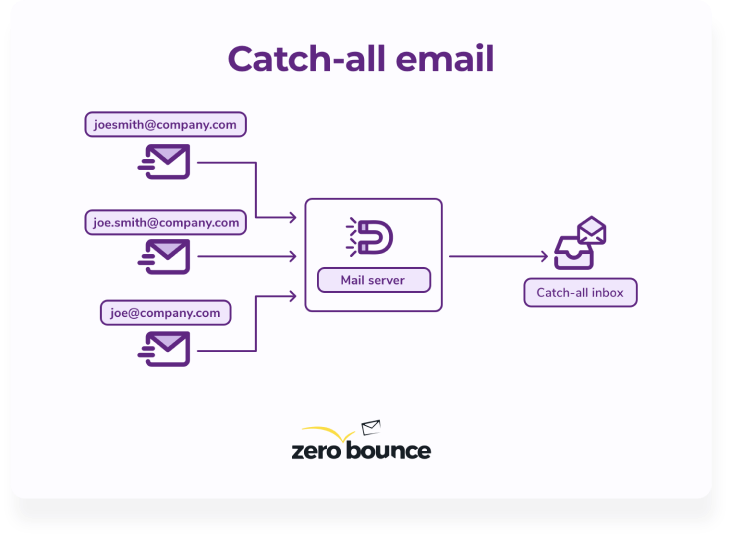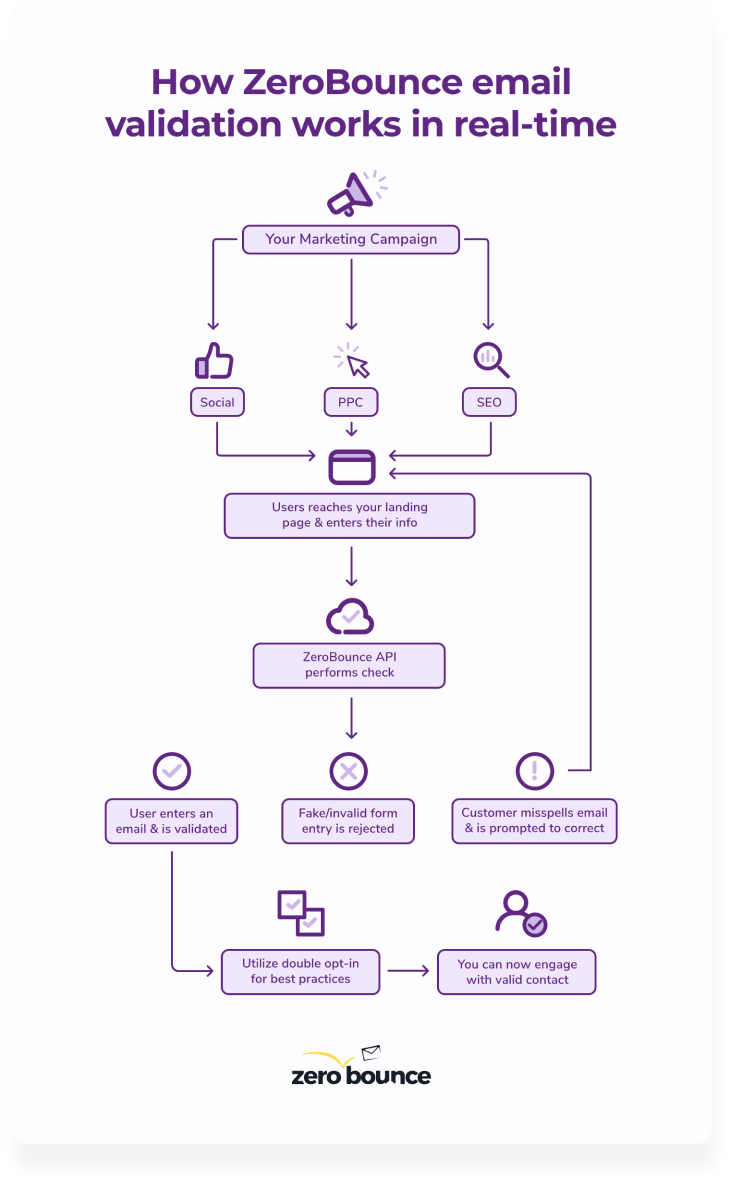How to Verify Catch-all Emails - An Email Marketer’s Guide
Catch-all email addresses are a frustration for email marketers.

Catch-all emails might connect you with someone at a company. But they may put your emails and reputation at risk.
By the end of this guide, you’ll know how to define a catch-all, why companies use them, how they impact your email marketing campaigns, and how to verify them.
As a bonus, we’ll show you how to score those catch-all addresses so you don’t miss out on potentially valuable leads.
What is a catch-all email?
A catch-all email, or an accept-all email, receives all messages sent to incorrect addresses on their corresponding domain.
Users misenter addresses regularly. We may contact someone at a brand using a predicted email pattern, only to be incorrect in our entry. The server will direct the message to the catch-all inbox if the domain is correct and a catch-all email address is available.
Many brands utilize accept-all emails to ensure they don’t miss out on vital communications. Something as simple as a typo can render an address invalid and cause an email to bounce. Instead, they would place the message in a valid inbox on their server rather than the alternative.

Why companies use catch-all email addresses
Many brands utilize accept-all emails to ensure they don’t miss out on vital communications. Something as simple as a typo can render an address invalid and cause an email to bounce. Instead, they would place the message in a valid inbox on their server rather than the alternative.
Ideally, someone at the brand will manage the catch-all box. Once they understand the context of a message, they can forward it to the person best fit to deal with the email message.
How accept-alls impact your email marketing campaigns
Catch-alls exist to help brands deal with a high volume of communications. This should be great news for you as you can reliably connect with companies even if your lead address needs updating.
While a catch-all email is a valid address, there are problems you need to look out for as an email marketer.
Need a way to identify catch-all emails?
Verify the address now - free
Spammers target catch-all email address
The problem with an email address catching every message is that they also collect spam. You just need a domain name, not a name or role, to push your content to the inbox.
No one wants mystery content from unknown or untrusted senders.
As a company’s catch-all inbox floods with unwanted content, they stop managing it as carefully. They may even abandon the inbox altogether. Your valuable content eventually sits unopened next to hundreds of spam messages where no one will ever see it.
Messages to an accept-all email may bounce
Some accept-all inboxes only serve a temporary purpose. Companies set up a catch-all address only to disable it later. It either fulfilled its purpose or became too contaminated with spammy content.
Most verification tools will only identify a catch-all. It can’t tell you if it's inactive. Thus, you risk bounced messages when emailing an accept-all address.
Catch-all emails can also be valuable prospects
Catch-alls are a tricky dilemma. Just because some brands abandon their catch-all emails due to spam does not mean they all will. A dedicated person may manage the inbox, sorting the valuable content from the spam. If you email the correct catch-all address, you may receive a reply from a person at the company.
But leaving your email marketing to chance isn’t an intelligent choice. Conserving your budget and protecting your reputation is safer than taking unnecessary risks.
Most email validators can only identify a catch-all
When it comes to invalid and risky email types, email validationⓘA process that determines if an email address uses valid syntax, exists on a given domain, and is configured to receive incoming email messages is the solution. It helps email marketers differentiate real contacts from spam traps, catch-alls and other harmful address types.
An email validation tool also detects catch-all inboxes but stops there. You know which contacts on your email list have this status, but you still need to learn which is quality.
Purging an unknown catch-all email address is preferable to landing in a dormant inbox. Maintaining high clickthrough and engagement rates is better for your email reputationⓘAlso referred to as ‘Sender Reputation.’ This describes how trustworthy a sender is when sending emails. Reputation is influenced by past campaign performance and sending habits, including bounce rate, spam complaints, abuse reports, email authentication, sending volume, and domain history..
However, you paid to acquire these leads with your marketing efforts. You may lose out on substantial sale opportunities by outright abandoning a catch-all email address.
Fortunately, there is a solution available to help combat these known issues.
How accept-alls impact your email marketing campaigns
Spammers target catch-all email address
Messages to an accept-all email may bounce
Catch-all emails can also be valuable prospects
Most email validators can only identify a catch-all
How to verify a catch-all email
You must use an email validation service to verify your email contacts. This allows you to determine which addresses are valid and safe to message.
During the process, the service also helps you identify all types of problematic emails, including:
- Disposable emailsⓘA temporary email address that users can create using a temporary email website or creation tool. You can use a disposable email address for a brief period before it expires and becomes invalid.
- Abuse emails
- Spam traps
You should purge all of these from your list without hesitation. Doing so will immediately reduce your bounce rate, improve engagement, and maximize inbox deliverability.
An email validation API can further protect your email list. This is code you can easily install on your websites, landing pages and wherever you collect email leads. Whenever a user enters their email on a form, the API validates it. If it happens to be invalid or risky, the API will automatically reject it from entering your email list.

But there’s still the dilemma of understanding your catch-all emails. Thankfully, we offer a solution with ZeroBounce Score.
With the help of artificial intelligence, our email validation service also detects recent email activity levels for each contact. It is a ten-point scale that describes each email address as follows:

Scoring provides you with the necessary information to adequately verify your catch-all emails. Someone is likely managing the inbox if the address has a high score. On the other hand, catch-all emails with low scores are safe to eliminate from your list.
You can then make informed decisions regarding your email list and campaigns. If you observe no activity or bounces from the catch-all address, promptly remove it from your email list.
Related links:
Frequently asked questions
Catch-all, sometimes called accept-all, means that the receiving address accepts all incoming emails. This is useful whenever the sender makes a typo or enters an invalid email on your domain. Instead of bouncing the email back, the server redirects it to the catch-all inbox.
This status refers to a type of email known as catch-alls. Catch-alls are valid addresses that accept emails initially sent to an invalid address on a domain. These risky emails receive their own status, as they can harm your reputation if the inbox is unmanaged or dormant.
Yes - but only to an extent. An email validation tool will identify any catch-all email addresses on your list. The bigger problem is verifying whether or not the inbox receives active use.
You can gain insight into a catch-all email by using ZeroBounce Score. This gives you a score from 1-10 regarding an email user’s activity level, with 10 being the most active and zero being inactive or unknown.
Use an AI scoring tool like ZeroBounce to gauge the activity levels of a catch-all email user. Emails with low activity are likely out of use, and you should scrub them from your list immediately. If the inbox displays recent activity, you may choose to send emails to that inbox.
It’s risky to send messages to accept-all emails as it’s difficult to predict if someone is actively managing the inbox. If there is any doubt, removing an accept-all email from your list is safer.
You can send emails if you believe an active catch-all inbox is a valuable lead. Consider removing the catch-all from your list if your email bounces or goes unopened. Use ZeroBounce AI scoring to understand a catch-all email’s activity level better.
Contents
- Overview to find more details about links
- What is a catch-all email? to find more details about links
- Why companies use catch-all email addresses to find more details about links
- How accept-alls impact your email marketing campaigns to find more details about links
- How to verify a catch-all email to find more details about links
- Frequently asked questions to find more details about links